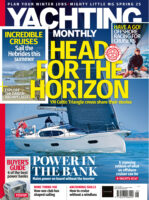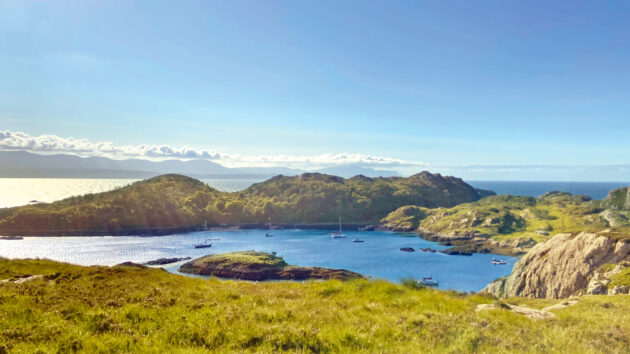Joanna Martin and her husband Mark sail across the Irish Sea to the legendary sea kingdom and to draw the wonderful wildlife there
The magic and mystery of the western isles of Scotland capture my imagination and draw me back every summer. This once-great sea kingdom ruled by the Norse and Gaels is a landscape of breathtaking beauty and a haven for wildlife, which inspires my art.
We left Strangford Lough in our Moody 33 Bonaventure II at 0400 on 10 July, pushing against the last of the flood tide to get to the mouth of the ‘Narrows’. Catching the tide, and with favorable conditions, we kept going until we reached Glenarm Marina, 54 miles away, a convenient stop-off for passage-making to the Hebrides.
There was a fiery sunset that night, hopefully an omen of good weather. Departing at 0500 the next morning, the early morning light lit up the Glens of Antrim on our port side, looking like a patchwork quilt of greens. The Mull of Kintyre in contrast looked dark and forbidding. The strong current through the North Channel helped us reach Gigha in seven hours, mostly motor-sailing in a light southerly. On the way, we saw porpoises, gannets, Manx shearwaters, razorbills, and guillemots.

Joanna sketches aboard while under way
We had now reached the west coast of Scotland and the area which was the Kingdom of the Isles. Stretching from the Outer Hebrides to the Isle of Man (see map), this area was controlled from the 9th Century by the Norse before Somerled, a Lord of Argyll, took control in the mid-12th Century.
Somerled and the next four generations of his family styled themselves as Righ (king) with the later four generations known as the Lords of the Isles. At their height, they were the most powerful landowners after the kings of England and Scotland, and their kingdom was almost completely independent. They ruled and protected their land by sea with fleets of galleys and had a parliament at Finlaggan, on the island of Eilean Mor in Loch Finlaggan on the Isle of Islay, where they would pass their own laws and acts.
Article continues below…
Sailing across the Irish Sea: ‘We had never seen such evocative scenery’
Bleary eyed, we stumbled out of our sleeping bags as the boat rocked gently on her berth. Fumbling around we…
Sailing to the Scillies and back: ‘In the timeless rhythms of the ocean, this latest period of flux and profound change is the greatest’
Being poked in the cheek and asked ‘Is this annoying? Is this annoying? Is this annoying?’ by my bored 11-year-old…
At the island of Gigha, we picked up a visitor’s buoy in Ardminish Bay. This is a beautiful, community-owned island edged with white sandy beaches. We met up with friends here on yacht A Capella of Belfast with whom we would be cruising in company. We got supper from The Nook seafood takeaway with a locally sourced menu offering tempura squid, halibut panko bites, lobster, and pickled samphire. I always like to buy the island’s glass-bottled, traditionally made milk produced by the Wee Isle Dairy.

The Cuillins on Skye seen from the Narrows of the island of Raasay. Photo: Joanna Martin
Whirlpools and colour
The next day we headed up into the Sound of Jura, dropping anchor in Kinvachdrach Harbour on the north-east corner of Jura for lunch. We walked up to the very north of the island for a panoramic view of the notorious whirlpools of the Gulf of Corryvreckan. The route back across the Sound to Ardfern Marina took us through the tidal race Dorus Mor, Gaelic for ‘rough wild water’. The chandlery here has an excellent shop that sells my greetings cards, so I like to keep in touch.
Moving on, we had an evening sail to Easdale Sound, wind WNW Force 4, a rather austere former slate mine where we anchored for the night. The weather was overcast with rain showers as we made our way across the Firth of Lorne and into the Sound of Mull, motor-sailing into the wind. The sun came out and, as always, Tobermory’s colorful seafront filled me with joy.
Revisiting the puffin colony on Lunga Island is always top of my wishlist, but our planned route was to continue north for Skye. To avoid a huge detour to the Treshnish Isles on the west coast of Mull, we opted, on this occasion, to take a ferry trip with Staffa Tours. The tour boat stopped at the Isle of Staffa first and Fingal’s Cave was truly spectacular. Despite being with a group of fellow sightseers, it didn’t spoil the moment as we all stood in silence, gazing in awe at its scale and construction. The perfectly formed, hexagonal basalt columns rose out of the turquoise water to form a remarkable ceiling. Beside the landing place is an island called Am Buachaille, where a pyramid of black and gold columns twist and curve; pristine as if freshly created.

Joanna’s journal mixes notes, maps and sketches – here of the wildlife on Skye. Photo: Joanna Martin
A puffin welcome
I was excited to be back on the Isle of Lunga with the puffins; I always forget how small they are. The most accessible place to observe the colony is a flat grassy platform above a cliff, on the edge of which are their nesting burrows. I sat and sketched them, enjoying their antics as they interacted. The atmosphere is friendly, noisy, and busy as they fly back and forth with sandeels to feed their ‘pufflings’.
After making the most of the marina facilities at Tobermory, we motor-sailed around Ardnamurchan Point, the most westerly point on the west coast. The wind picked up, and with a WNW, we sailed at 6 knots, with the tide behind us, to the Isle of Eigg. A pod of dolphins joined us, diving under the boat. We anchored in Pullnaparton Bay and after a walk, enjoyed a cold cider in the newly constructed Galmisdale Bay Bar. With a Skandi feel, this building includes a café and shop. The views looking towards Ardnamurchan were stunning.
The leg towards Portree was one of increasingly dramatic scenery and a sense of wildness. We overnighted on a visitor’s mooring at Ornsay. We watched a seal energetically hunting its prey in the Sound of Sleat. We were motor-sailing up the Narrows of Raasay in the early evening with the Red Cuillins laid out in all their splendor on our port side when a silvery dolphin leapt out of the water right next to us, giving me and it quite a fright!

: Anchored in Portree on the Isle of Skye with the Cuillins in the background. Photo: Joanna Martin
As we got closer to Portree harbour, the sea got quite lumpy and the landscape more harsh with high dark cliffs rising next to us. All of a sudden, a huge shaggy bird swept down from a rocky ledge and I identified it as a white-tailed eagle, my first sighting. With a wingspan of up to 2.4 metres, these once extinct birds were reintroduced to Scotland from Norway in 1975 and there are now estimated to be 152 pairs.
Skye and Rona
I really like the town of Portree on the Isle of Skye and it seems I’m not the only one. While we were there, a Fred Olsen cruise liner arrived, and we watched the tenders endlessly ferrying the passengers ashore. The crossing to the Isle of Rona took a couple of hours, close-hauled. This is the deepest stretch of water on the UK continental shelf, descending to 324 metres.
We picked up a visitor’s mooring in Acairseid Mhor, a natural harbour with a rocky entrance. This island is owned by a Dane and we noticed Danish ensigns on two of the visiting yachts. Once wooded, Rona is now bare and rugged but with good walking tracks. The 360° view from the triangulation point above the harbour took in mountain ranges in all directions. Seals snoozed on the rocks and an eagle flew far above. Shortly after we left the island, an orca and humpback whale were spotted nearby.

Joanna takes the helm around Dunvegan Head on Skye. Photo: Joanna Martin
After being weatherbound for a day, we dropped our mooring at 1200 on 24 July heading for the northern tip of Skye. On our port side was the Old Man of Storr and the picturesque Mealt falls dropping 55m from a clifftop. I saw gannets gathering, flying from all directions until 20 of them were wheeling around above what must have been a shoal of fish. They began to dive arrow-like into the sea, dolphins and gulls joining the feeding frenzy.
On our circumnavigation of the Isle of Skye, I was spellbound by the headlands, high cliffs, sea stacks, and caves with the Cuillins purple in the background. Occasionally an eagle would swoop down from the cliffs, and seal colonies gathered on rocks. Mark practiced using his sextant and I illustrated my journal.
We anchored in Canna Harbour as all the visitor buoys were occupied; it is a popular cruising destination. This is one of my favourite islands to visit because of the pretty geography, the walks, wildlife, and not least of all, the excellent Canna Café. We ended up being stormbound here for a few days and had some challenging trips ashore in our tender. Luckily our anchor held.

View from the Boathouse Café on the island of Ulva with Mull behind. Photo: Joanna Martin
We weighed anchor at 0600 heading south towards Coll. Once we were in the Sound of Canna, the waves became enormous. This was probably due to the shallow shelf off Rhum causing the swell to become higher and steeper. By taking the helm, I managed to avoid getting seasick. The mountains were swathed in a blanket of cloud; it was beautiful.
The Island of Ulva is an enchanting and magical place. It has a feeling of undisturbed nature, with a network of paths leading through woods draped in moss and lichen. I saw every sort of wildflower and spotted otter and deer footprints. There’s a café on the quay called The Boathouse and a small foot ferry crosses to the Isle of Mull. Here there was an eight-berth pontoon and a new ‘community hub’ facilities building under construction. Mark went fishing
Enjoyed reading this?
A subscription to Yachting Monthly magazine costs around 40% less than the cover price, so you can save money compared to buying single issues.
Print and digital editions are available through Magazines Direct – where you can also find the latest deals.
YM is packed with information to help you get the most from your time on the water.
-
-
- Take your seamanship to the next level with tips, advice and skills from our experts
- Impartial in-depth reviews of the latest yachts and equipment
- Cruising guides to help you reach those dream destinations
-
Follow us on Facebook, Twitter and Instagram.






